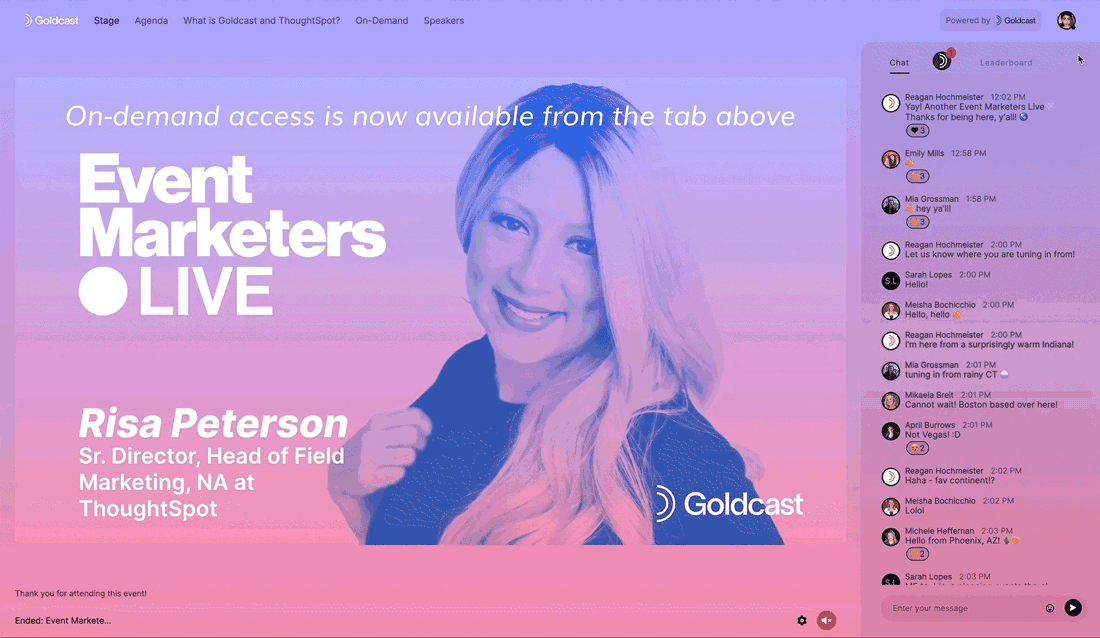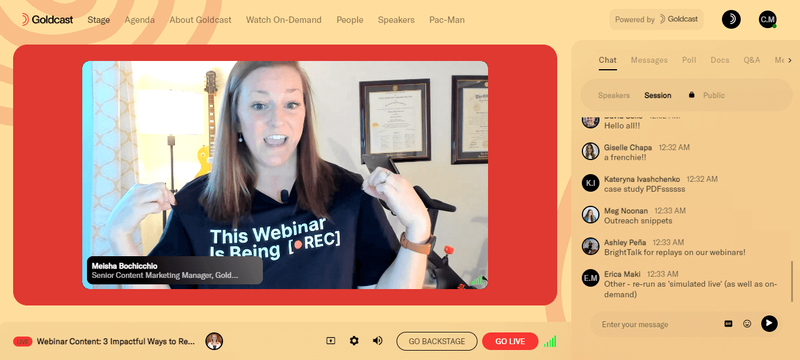6 Psychology Principles to Keep Your Event Attendees Engaged

Table of Contents
Maximize Your Marketing ROI
Join 10,000 other marketers already getting the best tips on running engaging events that boost pipeline and create raving fans.
Keeping your audience engaged during virtual events is a top goal for most marketers. While there are lots of tactics and strategies out there to grab people's attention and hang onto it, there's no surefire solution.
Wouldn't it be a dream to get into your audience's brains and know exactly what they're thinking?
Well, we aren't quite there yet, but we can understand human behavior and thought processes via psychology. From there, we can uncover ways to use that info to improve audience engagement during our events!
The following six applied psychology principles can lead to higher engagement rates during your events. Sound good? Don your learner hats, and let's go back to school!
Here’s what we’ll cover:
- Information-gap theory
- Law of least effort
- Scarcity
- Gamification
- Social proof
- Reciprocity
Principle #1: Information-gap theory
When you plan to buy a high-value product, like a car, you usually start out by learning as much about that product as possible. For example, you may read a buyer’s guide, speak with your auto-enthusiast friends, and watch YouTube videos before visiting a car dealership for a test drive.
You're essentially trying to fill the gap between what you know and what you don’t so you can make the right decision. This difference in knowledge is referred to as an "information gap," and you can see people trying to bridge it all day long on the internet.
In fact, information gap theory is exactly what inbound marketing efforts are built around!
Aside from looking to make purchase decisions, people also may look for information to satisfy their curiosity. Either way, there's an opportunity to hook readers, answer their questions, and get on their radars as a potential solution.
How you can apply it:
- Create content for every part of the marketing funnel. Think about what people search for at every stage of their journey, and then design events and content around answering those questions.
- Use testimonials from attendees to showcase how prior similar events helped them solve problems and get the information they were looking for.
- Speak directly to existing knowledge gaps through your event title and promise to address them during your event. Just make sure to deliver on that promise!
Principle 2: Law of least effort
You've probably heard that scrolling social media apps releases little hits of dopamine, which is a reward chemical released in the brain during certain stimulating activities.
However, did you know that exercise also releases dopamine? Yet you probably know many more avid social media users than exercisers, right?
The law of least effort explains this phenomenon by pointing out that people will opt for the activities that require the least amount of effort for the reward. Social media apps are super easy to use; you just log in and start posting, and you're likely to generate some notifications or likes. Exercise, on the other hand, is a bit more involved!
The law of least effort is evident in the user experience of well-designed products and apps. You may notice signup and login buttons highlighted more prominently on the page than other page links; this is all intentional.
How you can apply it:
- When promoting your event—whether you are sending an email, running an ad, or setting up a LinkedIn event page—ensure users can easily find the event link. Never bury it! Similarly, don’t forget to include automatic calendar holds in your emails to make it easy for folks to remember to attend.
- During the event, tell your attendees what action steps they should take next. Do you want them to participate in a poll, ask questions, or do something else? Don’t overwhelm them with multiple options; keep it simple and direct!
- Keep the input fields on your registration forms proportional to the value the event will deliver. For example, if you’re running a top-of-funnel webinar, you don't have to capture a ton of information on every prospect. Name, email address, and company title or job role are probably sufficient.
Principle 3: Scarcity
One of the reasons exclusive artwork sells at higher prices is that it's harder to obtain. If there's only one painting, it's more likely a bidding war will occur than if you've got 100 prints to sell.
The scarcity principle drives this behavior and states that the attractiveness of an object increases as it becomes more difficult to obtain. If you've ever heard, "People only want what they can't have," that's the scarcity principle at work. The fear of missing out, or FOMO, is another commonly recognized offshoot of the scarcity principle.
You probably see this all the time. If you've looked at an item and been notified there are only 1-2 left in stock, or if you've noticed a countdown timer on a page to buy concert tickets—you've seen the scarcity principle being used.
One important note: While it's tempting to employ the scarcity principle to your advantage, doing it in a disingenuous way can backfire on you. Studies have shown that if people think it's just a sales tactic, they're not likely to respond well to scarcity-related messaging.
How you can apply it:
- Create a sense of urgency to boost registrations. For example, allow only a specific number of early bird registrants and highlight the number of spots left on the registration page to drive action. You can also display a countdown timer on the website to let people know how much time is left to sign up.
- Offer exclusive benefits. This might look like an exclusive offer, like a free consultation or an extended free product trial. You might offer this to a specific, high-value segment of your audience to generate momentum and drive future conversions.

Principle 4: Gamification
We've already talked quite extensively about gamification, and that's because it works!
Holding the audience's attention gets tricky during virtual events, and gamification helps you keep things interesting by introducing game mechanics and elements to your event experience.
Gamification provides frequent, positive user feedback and motivates them to keep doing something. The feedback could come in the form of points, badges, or leaderboards and gives users a sense of achievement and a healthy dose of friendly competition.
How you can apply it:
- Digitize offline engagement activities. For example, you can reward early check-ins, run trivia questions or an in-event bingo game, organize a virtual scavenger hunt, or gamify the icebreaking session.
- If you use Goldcast for events, you can integrate third-party apps like Engamio, Webooth, Drimify, and Snapbar to introduce fun features like games and photo booths!
- You can tie gamification to actual rewards. For example, while ranking top on a leaderboard can be encouraging, pairing that accomplishment with a physical gift provides a novel experience.

Principle 5: Social proof
Have you ever purchased something because a friend, peer, or your favorite celeb recommended it? Or did you decide not to buy a product after reading terrible ratings and reviews?
This is how social proof works.
Social proof is a phenomenon in which people decide for themselves based on the opinion or behavior of others. In other words, it’s herd behavior.
You can see social proof's marketing application through word-of-mouth (WOM) campaigns, testimonials, expert opinions, celebrity endorsements, social media signaling/sharing, influencers, and certification/badges.
How you can apply it:
- Since speakers are experts in your niche, record a short video of them talking about how attendees can benefit from your event. Then, the speakers can promote the video through their various marketing channels. You can also create unique discount coupon codes for each speaker they can share along with the video (tying back into exclusivity!).
- Showcase past attendee testimonials on the event landing/registration page, within emails, and in your social media posts.
- Create an event hashtag for social media. Encourage attendees to tweet or share photos with the hashtag. You might even feature the best content on the social wall for the event!
- If your event had impressive attendance numbers in the past, talk about it! People will want to see what the buzz is all about.
- Once you collect the post-event survey, see what data or feedback you can repurpose into social proof content. This creates a steady supply of testimonials, quotes, and other content you can use.
Principle 6: Reciprocity
The reciprocity principle is a tendency to do unto others as they do unto you. It's why you might automatically smile back at someone when they smile at you, even if you don't know them.
You can view examples of reciprocity across all aspects of life because it gives people a mutual benefit. The best part is, even if you can't offer something material in return, verbal affirmations can have the same emotional effect! Thanking attendees for their time after an event, for example, can make people feel valued and connected to you.
How you can apply it:
- Offer special promos to past event attendees or email subscribers as a token of gratitude for their time and investment. You can also launch a community and organize exclusive events for that audience.
- Make your attendees feel special by sending meaningful physical or virtual gifts through Alyce. You can also up the notch of your gifting initiatives through smart gifting!
- Offer incentives for participating in polls and post-event surveys; this might be a good chance to incorporate gamification as well.

Apply psychology principles to drive engagement
Understanding what moves people will help you host more engaging events. Whether it's making things a bit easier for people (law of least effort) or leaning on testimonials to drive registrations (social proof), there's lots to draw from here!
While these individual ideas are great on their own, we encourage you to brainstorm some ways you can combine two or more principles to really engage folks. Many of them mix and match quite well, and we'd love to hear from you what worked!

Transform Your Video Marketing with AI
Stay In Touch
Platform
Resources
© 2026 Copyright Goldcast, Inc. All rights reserved.





 Upcoming Events
Upcoming Events Event Series
Event Series On-Demand Events
On-Demand Events

